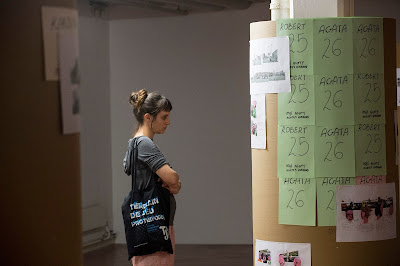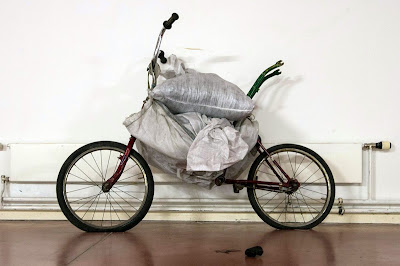Polonia Bytom, 2016
Akademie Schloss Solitude in Stuttgart and CCA Kronika
Gallery in Bytom
list of works presented at the exhibition:
Polonia Bytom (2016) – art book
Patriots (2013-2015) – script for a feature film
Patriots (2015) – series of storyboard-collages, A4 and
A3, inject print on paper, play dough, glue, bic and markers
Untitled (2016) – readymade (a bicycle customized in order
to serve as a trolley for coal collected on the rail tracks in Bytom, two sacks
of coal)
Untitled (2016) – readymade (a broken smartphone)
Questionnaire (2011) – video, black & white + sound, 4ʼ, looped, PAL, 4:3
Untitled (2016) – video installation composed of two screens facing each other:
– Centraal Station (2015) – video, color + sound, 19’55’’, looped, HD, 16:9
– Bobrek (2016) – video, black & white + sound, 19’55’’, looped, 4:3 and 16 color slides turning on a carousel
– Centraal Station (2015) – video, color + sound, 19’55’’, looped, HD, 16:9
– Bobrek (2016) – video, black & white + sound, 19’55’’, looped, 4:3 and 16 color slides turning on a carousel
text:
The Polonia Bytom installation – exhibited in Akademie Schloss Solitude in Stuttgart and CCA Kronika Gallery in Bytom – combines different media (video installation, storyboard-collages, script for a feature film, sculpture and art book) in order to reflect on the personal histories of the recent economics related migrations within EU.
In the script titled: Patriots I created a group portrait of Polish guest workers in the Netherlands, in order to expose how their identity and subjectivity is registered and constructed through a variety of media, genres and performative actions (including through films made by smartphones or surveillance cameras, the documentary genre and self-performance). The protagonists of the script, constantly travelling between their countries of origin (where their friends and families live) and the Netherlands (a place of work), are unable to ever settle at a home. They do not feel fully rooted in their new environment but due to lack of prospects for the future in Poland, they decide to go to the Netherlands for primarily economic reasons. Life in Rotterdam forces them to confront a new identity – that of an immigrant, who is obliged to adapt to a new country while at the same time being stigmatised by a web of clichés and negative stereotypes.
The main
subjects of the Patriots are power relations with the omnipresence of cameras
in the Poles’ lives as one of their key elements. The film script focuses on
the narcissistic pleasure of being watched and heard, which leads the
characters to willingly “perform” their privacy and confess to the cameras. Moreover
the script’s individual story lines tell on the one hand of the surveillance in
public places in the Netherlands and of the patronising attitude to immigrants
at integration courses and on the other, of competition for domination between
individuals. An important element of the relations between the characters from
different social backgrounds is their constant need for achievement, for good
results at work, for integration, learning the language and winning acceptance.
Images of people appearing in the Patriots storyboard-collages that serve as faces for my protagonists were
found in the Internet. Therefore, regardless to the situation, the protagonists
of the storyboard don’t change their facial expression – as if there were
always posing in front of the camera. Yet, there is “layer of drama” within the
work; it is build by the use of play dough stick to the collages. I have chosen
this material because it is something that we intensely touch; it evokes the
“physical” presence. This is meant to build juxtaposition to the virtual communication
on smartphone or Skype, that is an everyday reality of my migrant protagonists.
In the Patriots script and the storyboard-collages (showing only the exteriors from the film) I also depicted two disparate cities: Rotterdam in the Netherlands and Bytom in Silesia (Poland). I portrayed the Dutch city as a playground for modern architecture, serving the migrant workers as a background for selfies. On the contrary Bytom – where the characters of the script and the collages come from – is a city, which “lacks the main protagonist”. Within the plot of the movie a little girl captures Bytom with her smartphone. She sends her films to her father, who works and lives in the Netherlands.
Bytom – a shrinking city, where buildings are collapsing due to the damages related to mining – is also portrayed in the art book Polonia Bytom, that is an effect of my collaboration with Joanna Bębenek and Justyna Chmielewska. Within this catalogue we will find almost no people at the photographs depicting the Silesian city. “There is only the skeleton of the town, its dis-use. [Bytom] is a town that has undergone constant transformations, making endless attempts to turn the corner. Located in the heart of industrial Upper Silesia, it has been, like the entire region, the site of many transits and migrations, resulting from the tides of history and the ruthlessness of the capitalist economy. ”*
The script, the art book and the storyboards-collages are presented at the exhibition’s space together with two video installations. The Centraal Station video’s footage was taken at the Rotterdam’s main train station in 2015. It registers an existing screen placed in the main hall of that building, that presents to the commuters and newcomers a film about Rotterdam’s harbour. At the Polonia Bytom exhibition this narrative is facing the Bobrek projection, consisting of 16 photos of contemporary Bytom, moving at slides carousel. The photographs are rhythmically interrupted with empty spaces of light (the carousel has place for 80 slides) and one scene from Jan Rybkowski’s Autobus odjeżdża o 6.20 feature film (1956), projected at the same place as the slides. The fragment of Rybkowski’s movie is showing a female worker coming by train to Bytom, in order to start to work at the local ironworks.
The script, the art book and the storyboards-collages are presented at the exhibition’s space together with two video installations. The Centraal Station video’s footage was taken at the Rotterdam’s main train station in 2015. It registers an existing screen placed in the main hall of that building, that presents to the commuters and newcomers a film about Rotterdam’s harbour. At the Polonia Bytom exhibition this narrative is facing the Bobrek projection, consisting of 16 photos of contemporary Bytom, moving at slides carousel. The photographs are rhythmically interrupted with empty spaces of light (the carousel has place for 80 slides) and one scene from Jan Rybkowski’s Autobus odjeżdża o 6.20 feature film (1956), projected at the same place as the slides. The fragment of Rybkowski’s movie is showing a female worker coming by train to Bytom, in order to start to work at the local ironworks.
Moreover the Polonia Bytom installation consists of two sculptures, evoking two approaches to the entrepreneurship. First one is a smartphone – an object used frequently by the protagonists of my script and storyboard, who understand their identity and subjectivity as objects of production and consumption. Second one is a customised bicycle. This readymade serves in contemporary Silesia as a trolley for the scavengers. The poorest citizens of Bytom, who don’t have means to emigrate after facing unemployment in the postindustrial city, are forced to pick up coal at the train tracks and use customised bikes as a mean of transporting it.
What is at stake in the multitude of screens and images appearing within the Polonia Bytom installation is my attempt to regain the “physical” and to create an artwork where a screen could become a social sculpture.
*In an essay, published in the artbook Polonia Bytom, the Polish curator, art historian, and author Stanisław Ruksza writes about the project.
credits:
The Questionnaire (2011) footage is appropriated from two documentaries by Polish film director Kazimierz Karabasz: Na progu / On the Threshold (1965) and Próba materii / Material Test (1981).
The Bobrek (2016) consists of one scene appropriated from a film titled: Autobus odjeżdża o 6.20 (1954) by Jan Rybkowski and slides from contemporary Bytom made by Justyna Chmielewska and Anna Okrasko.
The Polonia Bytom (2016) art book is a collaboration of Joanna Bębenek, Justyna Chmielewska and Anna Okrasko. It is published by Akadamie Schloss Solitude in Stuttgart and CCA Kronika in Bytom.
photo credits:
Anna Okrasko
Marcin Wysocki
Frank Kleinbach












